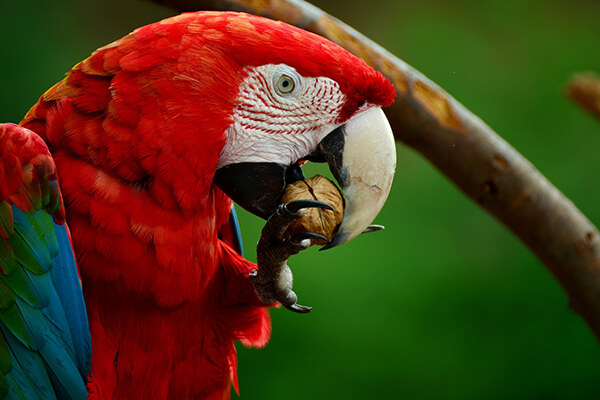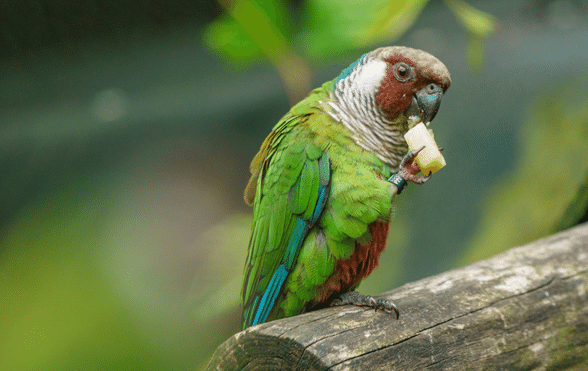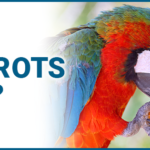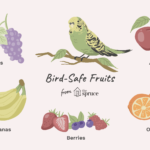Parrots in the wild eat fruits, seeds, nuts, flowers, and insects. Their diet varies by species and habitat.
Parrots are vibrant and intelligent birds found in diverse habitats worldwide. They thrive in rainforests, savannas, grasslands, and islands. These colorful creatures have a varied diet that ensures their nutritional needs are met. Wild parrots forage for fruits, seeds, nuts, flowers, and insects.
Each food type provides essential vitamins, minerals, and proteins. This varied diet helps parrots maintain their bright feathers and energetic behavior. Understanding their diet is crucial for conservation efforts and those who keep parrots as pets. Feeding parrots a balanced diet that mimics their natural intake promotes their health and longevity.
Natural Diet Overview
Parrots thrive on a diverse diet in the wild. Their food sources vary widely, offering a rich blend of nutrients essential for their health. This overview explores what parrots eat in their natural habitat, emphasizing the variety and nutritional needs.
Variety Of Foods
Parrots consume a broad range of foods. Their diet includes:
- Fruits: Berries, apples, and tropical fruits.
- Nuts: Almonds, walnuts, and pecans.
- Seeds: Sunflower seeds, pumpkin seeds, and millet.
- Vegetables: Leafy greens, carrots, and bell peppers.
- Flowers: Nectar and petals from various flowers.
These foods provide parrots with essential nutrients. The availability of these items varies by region and season.
Nutritional Needs
Parrots need a balanced diet to stay healthy. Their nutritional requirements include:
| Nutrient | Importance |
|---|---|
| Proteins | Essential for muscle development and repair. |
| Vitamins | Vital for immune function and overall health. |
| Minerals | Important for bone strength and metabolic processes. |
| Fats | Provide energy and support cell function. |
| Carbohydrates | Supply energy for daily activities. |
Each nutrient plays a crucial role in a parrot’s health. A varied diet ensures they get all these nutrients.
Understanding the natural diet of parrots helps in providing proper care. It ensures they receive a diet close to what they would eat in the wild.
Fruits And Berries
Parrots in the wild have a varied diet. Fruits and berries are a significant part of it. These colorful treats provide essential nutrients and energy. Let’s explore the common types and seasonal availability of fruits and berries that parrots enjoy.
Common Types
Wild parrots eat a variety of fruits and berries. Here are some common types:
- Bananas – Parrots love the soft texture and sweetness.
- Mangoes – Rich in vitamins and minerals.
- Grapes – Easy to eat and full of moisture.
- Berries – Blueberries, strawberries, and raspberries are favorites.
- Figs – High in fiber and natural sugars.
Seasonal Availability
The availability of fruits and berries changes with seasons. Here’s a simple table to show the seasonal availability:
| Fruit/Berry | Season |
|---|---|
| Bananas | All Year |
| Mangoes | Summer |
| Grapes | Autumn |
| Blueberries | Summer |
| Strawberries | Spring |
| Figs | Autumn |
Parrots adapt their diet based on what’s available. This ensures they get a balanced intake of nutrients. Seasonal fruits and berries provide variety and excitement in their diet.
Seeds And Nuts
In the wild, parrots enjoy a diet full of variety. Seeds and nuts form a significant part of their daily meals. These foods provide essential nutrients and energy.
Preferred Seeds
Parrots love different types of seeds. Sunflower seeds are a favorite due to their high-fat content. Millet seeds are small but pack a punch of energy. Safflower seeds are also popular among wild parrots.
| Seed Type | Benefits |
|---|---|
| Sunflower Seeds | High in fat and protein |
| Millet Seeds | Rich in carbohydrates |
| Safflower Seeds | Good source of healthy fats |
Nut Consumption
Wild parrots also enjoy eating nuts. Almonds and walnuts are commonly found in their diet. Pine nuts are a special treat for many parrots. These nuts offer protein and healthy fats.
- Almonds – Boosts energy and strength
- Walnuts – Good for brain health
- Pine nuts – Rich in vitamins and minerals
Flowers And Nectar
Parrots have diverse diets in the wild. One important part is flowers and nectar. These provide essential nutrients and energy. Let’s explore how these elements fit into a parrot’s diet.
Role In Diet
Flowers and nectar play a significant role in a parrot’s diet. They offer sugars, vitamins, and minerals. Parrots use their strong beaks to access these nutrients. The sweet nectar helps in providing quick energy. This is vital for their active lifestyle.
Popular Flower Types
Parrots prefer certain flowers for their nectar. Here are some common types:
- Hibiscus: Bright colors attract parrots.
- Bottlebrush: These flowers are rich in nectar.
- Eucalyptus: Parrots love the flowers and leaves.
These flowers are abundant in parrot habitats. They ensure parrots get needed nutrients.
Leaves And Vegetation
Parrots, with their vibrant feathers and lively personalities, are fascinating creatures. In the wild, their diet is diverse and includes various leaves and vegetation. This natural diet helps them stay healthy and full of energy. Let’s explore what types of leaves and vegetation parrots eat in the wild.
Edible Leaves
Parrots consume a wide range of edible leaves from different plants. These leaves provide essential nutrients and vitamins. They munch on tender leaves that are easy to digest. Some common leaves they eat include:
- Spinach leaves
- Kale leaves
- Dandelion leaves
- Clover leaves
These leaves are rich in vitamins A and C. They also contain minerals like calcium and iron. Parrots enjoy nibbling on fresh and juicy leaves. This helps them stay hydrated and energized throughout the day.
Plant Sources
Parrots also feed on various plant sources in the wild. These plants offer a mix of leaves, stems, and flowers. Some of the plants parrots rely on include:
| Plant Name | Parts Consumed | Benefits |
|---|---|---|
| Eucalyptus | Leaves and bark | Rich in fiber |
| Acacia | Leaves and pods | High in protein |
| Willow | Leaves and twigs | Contains antioxidants |
These plants not only provide food but also contribute to the parrots’ overall well-being. The high fiber content in these plants aids in digestion. The protein helps in muscle development, while the antioxidants boost their immune system.

Credit: www.youtube.com
Insects And Small Animals
Parrots are known for their colorful feathers and playful behavior. But what do they eat in the wild? While many people think of parrots eating fruits and seeds, these birds also consume insects and small animals. This helps them get necessary nutrients and proteins.
Protein Sources
Parrots need protein for their muscles and feathers. Insects are a great source of protein. Common insects eaten by parrots include:
- Beetles
- Grasshoppers
- Ants
- Termites
Small animals like lizards and baby birds are also part of their diet. This is especially true for larger parrot species.
Hunting Behaviors
Parrots have unique hunting behaviors to catch their prey. They use their strong beaks to break into insect nests. Some parrots dig in the soil to find worms and grubs.
Larger parrots may use their claws to catch small animals. This shows their versatility in finding food.
Parrots also use their intelligence to hunt. They observe and learn the best ways to catch their prey. This helps them survive in the wild.
Geographic Variations
Parrots have diverse diets in the wild, influenced by their geographic location. From tropical rainforests to temperate zones, the available food sources vary greatly. Understanding these geographic variations helps us appreciate the adaptability of these fascinating birds.
Tropical Regions
In tropical regions, parrots have access to an abundance of food. These areas are rich in fruits, nuts, seeds, and flowers.
- Fruits: Parrots love eating mangoes, papayas, and bananas.
- Nuts: Brazil nuts and cashews are common in their diet.
- Seeds: Sunflower seeds and palm seeds are favorites.
- Flowers: Hibiscus and other tropical flowers provide nectar.
Temperate Zones
In temperate zones, the diet of parrots changes with the seasons. These regions offer different foods throughout the year.
- Spring: Buds and young leaves are abundant.
- Summer: Berries and soft fruits become available.
- Fall: Parrots eat nuts, acorns, and seeds.
- Winter: They rely on stored food and hardy seeds.
Parrots in these areas must adapt to the changing availability of food sources. Their diverse diet helps them survive in varied environments.

Credit: www.anuts.com
Impact Of Habitat
Parrots live in diverse habitats. Their diet changes with their surroundings. Understanding their food sources helps in conservation efforts.
Forest Diets
In forests, parrots have a rich and varied diet. They eat fruits, nuts, and seeds. These birds often consume berries and flowers. They use their strong beaks to crack open nuts. Parrots also eat leaves and bark.
- Fruits
- Nuts
- Seeds
- Berries
- Flowers
- Leaves
- Bark
Savannah Diets
In savannahs, parrots eat differently. They consume more seeds and grasses. These birds also eat insects and small plants. They find food on the ground and in bushes.
- Seeds
- Grasses
- Insects
- Small Plants
Parrots have adapted to their environment. They find food based on what is available. This makes them resilient and resourceful. Understanding their diet is important for their care and conservation.

Credit: www.quora.com
Conclusion
Parrots thrive on a diverse diet in the wild, including fruits, seeds, nuts, and insects. Understanding their natural diet helps in providing proper care. Offering a variety of fresh foods can keep your pet parrot healthy and happy. Remember, a balanced diet is key to a parrot’s well-being.
Ryan Everhart is a passionate bird enthusiast and blogger, primarily writing on his website, Avian Whispers. His journey into the world of bird blogging began with a deep interest in parrots, a species that captivated his attention for their intelligence and social behavior. Over time, his content expanded to cover a broader range of bird species, offering insights into bird behavior, care, habitats, and conservation.
Ryan is dedicated to educating his audience, which includes both new bird owners and seasoned enthusiasts. His writing is filled with personal experiences, expert knowledge, and practical advice on bird care. Through Avian Whispers, he aims to foster a deeper appreciation for birds, emphasizing their role in nature and the joys of having them as pets.
Starting with articles focused on parrots, Ryan’s work now encompasses a diverse range of topics such as feeding, training, habitat enrichment, and bird health. His love for birds extends beyond parrots, diving into various avian species. His informative and heartfelt writing reflects his commitment to the well-being of birds and the desire to help others connect with these creatures.
As a growing voice in the bird blogging community, Ryan strives to provide a platform where bird lovers can learn, share experiences, and connect over a shared passion for avian life. His blogs are not only educational but also serve as a reminder of the importance of protecting and nurturing the bond between humans and birds.




